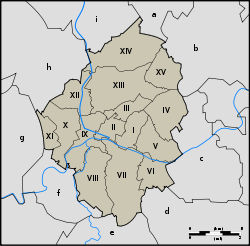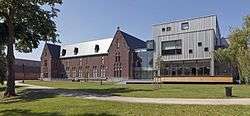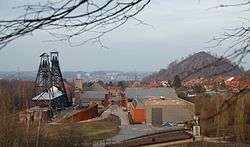Charleroi
Charleroi, located on the river Sambre, is the third largest municipality and fifth-largest city of Belgium situated in Hainaut province of Wallonia, the French speaking part of Belgium. A former mining town, it is viewed unfavourably by Belgians, who often see it as a poor, polluted and violent city that is not attractive at all.
Nevertheless, Charleroi indeed has its share of attractions, including unique museums such as the internationally-acclaimed Museum of Photography. It played an important role in the development of the Belgian comic strip culture, and in the world of modern dance, Charleroi has also become an important place due to its yearly festival. Charleroi also sees a high share of tourist traffic among Belgian municipalities as it is the location of the low-cost "Brussels South-Charleroi airport". While most tourists head straight from the airport to Brussels and other locations in Belgium, France and the Netherlands, the city itself is worth a go as well.
Understand

History
While there are remains of human settlements dating back to prehistoric times across Charleroi, it is actually a rather new city. It was only created in 1666 when the Spanish, who then controlled the Low Countries, started building a fortress there. It is the then King of Spain, Charles II, that the name of the town alludes to. This is why the inhabitants of the town are often alled Carolos.
The city was created at the beginning of a turbulent period, when it saw itself being turned over many times between the Spanish Crown, France, the Netherlands and the Austrian Empire, before finally becoming a part of the independent Kingdom of Belgium in 1830. It was only then when Charleroi became a boom town, as the local supplies of coal fuelled rapid expansion of mining, metallurgy and glass manufacturing. Charleroi and the neighbouring municipalities saw an influx of immigrants from all over Europe.
This all came to a halt following the rapid decline of mining and heavy manufacturing in the area following World War II. By 1970, Charleroi was battling rampant unemployment and poverty. In the following decades, it started reinventing itself as a hub for modern industries, such a bioscience and healthcare, and the city saw the resurgence of the popularity of its airport and its light rail system was reborn as the new metro.
Comic strip capital
Charleroi lays claim to being one of the birthplaces of the Belgian comic strip culture, as the Spirou magazine was published there first in 1938, featuring such popular comics as "Lucky Luke" and "Smurfs". This heritage is subtly reminded about throughout the city, e.g. at the metro station Parc you can see Lucky Luke murals, while further characters await for you at the Janson station.
Administrative organisation
The present-day Charleroi municipality actually comprises much more than just the historic city of Charleroi - it has been expanded in 1977 to encompass fourteen other directly neighbouring and farther small municipalities around the city. Therefore, there are as many as fifteen former town halls and fifteen separate town centres across Charleroi. That way, Charleroi also became the third-largest municipality in Belgium, as other large cities, including Brussels and Antwerp, remain divided into a number of different municipalities.
Charleroi is the capital of the Arrondissement de Charleroi, one of the seven districts of the province of Hainaut. The district includes further neighbouring municipalities, which are not part of Charleroi. There are about half a million people living in this district, a densely-populated and formerly heavily industrialized area.
Get in
By plane
- 🌍 Brussels South Charleroi Airport (CRL IATA) (a few kilometres to the north of the city). This airport is sometimes implied to serve Brussels even though the distance is some 55 km (34 mi). Ryanair and Wizzair both fly out of Charleroi to many European and North African destinations. TEC, the regional bus company, operates a bus line (bus A) between the airport and the Charleroi-Sud train station. A ticket can be bought on one of the ticket machines on the bus stop near the train station or at the driver when coming from the airport. The ticket costs €6,00.
By train
- 🌍 Charleroi South station (Charleroi-Sud), Square des Martyrs du 18 Août, ☎ +32 71 602 294. The main train station of Charleroi is located on the other side of the Sambre river, on the opposite of the city centre. Here starts the A bus line which goes to the airport. When coming out of the main building you need to get left to reach the metro and bus stops.
Get around
By public transport
Public transportation in Charleroi is provided by TEC, which is a regional operator responsible for public transit in all of Wallonia. In Charleroi, they operate a light-rail Metro system and bus lines. TEC is an acronym for Transport en commun which means public transportation.
- TEC Charleroi (City Bus service), Place des Tramways 9, 6000 CHARLEROI, Tel: +32 71 23-41-11 or +32 71 23-41-15
- TEC Charleroi, Esplanade de la Gare du Sud, 6000 CHARLEROI, Tel: +32 71 23-41-11. Ticket office at the north-west corner of Charleroi-Sud railway station in the métro léger station.

By metro
Métro léger de Charleroi, which translates as "light metro of Charleroi", is a light rail system that is a combination of underground rail and street-level tram/light rail, which is often referred to as a "pre-metro". In the city centre, it travels underground over a loop line, while going into the suburbs it becomes a ground-level light rail with separate right-of-ways or a street-level tram using the tracks of Belgium's former vicinal system.
There are four metro lines in Charleroi, all sharing the central loop and branching out to various suburbs and even as far as other municipalities.
- M1 and M2 travel eastwards of the centre sharing the route, but while M1 reaches as far as Anderlues, the M2 terminates at Pétria in Fontaine-l'Évêque
- M3 goes northwards to Gosselies. It is the newest part of the system, only inaugurated mid-2013
- M4 goes eastwards to the Soleilmont intermodal terminus in Gilly
The tourist office at the Charleroi-Sud railway station has a pamphlet describing sites and an itinerary along the Charleroi-Pétria métro léger line. It is effectively a tour by tram. You will probably want a day-pass for such an itinerary.
Do note that despite the extensiveness of the system, there is no direct connection by metro to Charleroi Airport.
Before 2012 and the inauguration of the underground loop, the metro had a different arrangement, operating as tram lines with double-digit numbers (54, 55, 84, 88, 89). And reference to those is now outdated and you should check which Metro line now serves the connection you want to make.
By bus
There are also several bus lines running across Charleroi.
By taxi
You can also use taxi to travel around in Charleroi. Taxi2share :+ 32 466 041 620 Taxis bleus/blauw (blue): +32 2 268 0000
See

Centre
The centre of Charleroi is relatively compact and walkable, encompassed within a ringroad known as the Petite Ceinture de Charleroi. Because Charleroi is located on a slight hill, the northern part of the centre is known as Ville Haute ("upper town"), and the southern part as Ville Basse ("lower town").
Ville Haute
The hexagonal Place Charles II marks the very centre of the city, featuring the uniquely eclectic Saint-Christophe church, which has seen additions from just about every architectural style since it was built in 1667, and the elegant town hall (Hôtel de ville) built in 1936 in an eclectic style mixing Art Deco with classicism. Its hind side faces the Place du Manège and features a tall belfry. On the other side of Place du Manège is the Palais des Beaux-Arts, featuring a Museum of Fine Arts.
The Ville Haute features numerous wide, tree-lined boulevards. On one of them, in the former barracks, you can find Musée des Chasseurs à pied, a museum dedicated to the history of the chasseurs, the Belgian rapid-action infantry who played a major and heroic role in the bloody fighting during the First World War. The barracks themselves are named after corporal Léon Trésignies, a chasseur hero of that period.
Walking through the streets of Ville Haute you can admire the architecture of the golden age of Charleroi, which fell between the historicizing eclecticism of the late 19th century and Art Nouveau. Some of the more interesting buildings are the 'Maison Maison Dorée at 15 Rue Tumelaire and Maison des Médecins at 40 Rue Léon Bernus.
- 🌍 Musée des Beaux-Arts, Place du Manège 1, ☎ +32 718 611 323 46.
- Jules Destrée Museum - dedicated to the notable Wallon politician - Hotel du Ville, Place du Manege, 6000 Charleroi, 32(0)71 86 11 32346
- Musée des chasseurs à pied.
.jpg)
Ville Basse
The most picturesque part of the Ville Basse is the Sambre, whose right (northern) bank features the tree-lined elegant boulevards Quai de Brabant and Quai de Flandre. The left (southern) bank is dominated by the Gare du Charleroi-Sud, the city's main train station, with an imposing historic building dating back to 1874, the middle of Charleroi's own golden age, and renovated in 2011.
South
Two of the most interesting attractions in Charleroi are situated in south of the municipality, in the former communes that were annexed by the city - the internationally acclaimed Museum of Photography in Mont-sur-Marchienne, and the former coal mine Le Bois du Cazier in Marcinelle. The metro system was not extended in this direction at all, but both sites can be reached by bus from Gare du Sud within 15 minutes. There is no direct bus connection between the two, you are best advised to go back by bus to Gare du Sud and change there.
Museum of Photography

- 🌍 Museum of Photography (Musée de la Photographie), 11 Avenue Paul Pastur (Cannot be reached by metro, but can be reached from Gare du Sud by buses no. 70, 71, 170 and 173. Get off at MONT-SUR-MARCHIENNE Place. The journey is less than 15 minutes with either line and the buses depart frequently.), ☎ +32 71 43 58 10, e-mail: mpc-info@museephoto.be. Tue-Sun 10:00-18:00, Mon closed. The renowned Musée de la Photographie à Charleroi is housed in the former Carmelite convent in Mont-sur-Marchienne, expanded by the addition of a thoroughly modern annex completed in 2008. It houses extensive collections of all sorts of photography from all periods, exhibiting them both as fixed and temporal exhibitions. Some of them are exhibited on the outside, in the convent's park.
Le Bois du Cazier

The colliery (coal mine) in Marcinelle was the site of the worst mining disaster in Belgian history, when an underground fire claimed the lives of 262 miners. While not remembered as vividly now, it was a pan-European tragedy, as the miners stemmed from 12 different countries, and this was a pivotal point in the history of coal mining and heavy industry in Belgium. Mines were subsequently required to comply with much more stringent safety standards, which saw many of them close as being uneconomical.
Le Bois de Cazier was also closed subsequently, but rather than being abandoned, it was turned into a unique museum complex, with most of it industrial heritage kept intact or adapted snd a number of artifacts collected, many kept in working condition. There is the Industry Museum, which presents not only coal mining, but also other heavy industries and the general technological and social progress of the 19th century. The Museum of Glass occupies a modern glass-and-steel addition to the complex, guiding visitors through a "countdown" from contemporary glassmaking technologies to the very earliest ones. In the workshops, a mixture of historic and modern machinery is still operated and blacksmiths continue to forge.
Le Bois de Cazier has also been turned into a site of remembrance of those who perished. A striking exhibition inside the former mine's buildings presenting the fateful day of August 8, 1956, the extent of the tragedy and its consequences. Outside, a park was organized in the 26-hectar estate of the former mine, with 12 species of trees planted to represent the 12 nationalities who lost their miners in the tragedy (and the seedlings were brought from those very countries). There are also three slag heaps, with the tallest spoil tip accessible by a modern skybridge, providing a striking panorama of the Charleroi area from its 250 metres.
The entrance fee to the site is €6 (€4.50 for students, and €1 less off either if you are in a group) and includes entry to all museums. At the site, you can participate in an organized group tour for €5 every first Saturday and Sunday of the month, at 3:30PM. Alternatively, a group of up to 25 people can rent a guide for €45 (covering entry costs as well), and a further €25 per group gets you an extra visit to the workshops. There are special activities offered at similar fees to organized groups of schoolchildren. Le Bois du Cazier also featured event rooms for up to 800 people for rent, and a souvenir shop.
The site is open Tuesday to Friday from 9AM-5PM, and from 10AM-6PM on Saturdays and Sundays. Do note it is closed on Mondays. There is no metro connection to Marcinelle, but the bus line 52 from the Gare du Sud takes you to Le Bois du Cazier.
- Site du bois du Cazier à Marcinelle, 80 Rue du Cazier, 6001 Marcinelle, ☎ +32 71 88-08-56, e-mail: info@leboisducazier.be.
- Musée du verre.
Other places of interest
- Charleroi Expo. Is an exhibition centre with a year-round programme of themed events
- ULB Scientific Cultural Centre (Centre culturel scientifique de l'ULB).
- Musée archéologique
Do

- Markets. If you are in Charleroi on a Sunday, do not miss the markets that spread out from Place Charles II over neighbouring streets.
- Cinéma Le Parc, Rue de Montigny 58 2338. A cinema.
- Royal Charleroi Sporting Club. Football.
- Spirou Charleroi. Basketball.
Buy
- 🌍 Tropica BD, Rue de Dampremy 39. The comic strip bookstore with a selection of albums full of Charleroi-born characters.
- 🌍 Ville 2, Grand Rue 143, ☎ +32 71 28 62 10. A mall just northeast of the centre.
Eat
- 🌍 Le Croc Midi, Rue du Calvaire 22a, 6041 Gosselies, ☎ +32 71 35 04 58, e-mail: info@lecrocmidi.be.
- 🌍 La Gondola, Place Emile Buisset 7, ☎ +32 71 31 30 17.
- 🌍 De Vous a Nous, 42 Rue du Grand Bry, 6110 Montigny-le-Tilleul, ☎ +32 71 47 47 03. In Montigny-le-Tilleul, a neighbouring commune south of Charleroi. €32 for a two-course meal.
- 🌍 L’Eveil des Sens, 105 Rue de la Station, 6110 Montigny-le-Tilleul, ☎ +32 71 31-96-92. €60 for three courses.
Drink
Sleep
Given the short distances to other Belgian cities, most people staying overnight are likely to be passengers at "Brussels South" airport. Unfortunately there are no hotels at the airport terminal itself, and reaching those nearby is difficult without a car. However, several hotels offer shuttles to the airport.
- 🌍 ibis Charleroi Gare, 12 Quai de Flandre (Facing the Gare du Sud and the bus station just across the river Sambre), ☎ +32 71 206060. Based in a historic building at the Quai de Flandre, this ibis hotel has an extremely convenient location. Inside, it is a standard ibis outfitted according to the brand's former standards. €59.
- 🌍 ibis Charleroi Aéroport, 590 chaussée de Charleroi, 6220 Fleurus (7km away from the terminal at a motorway junction), ☎ +32 71 810130. €59.
- Best Western Charleroi, 1A Boulevard Mayence.
- Les Balladins, Route de la Basse Sambre, ☎ +32 71 420168.
- Le Piersoulx, Rue du Grand Piersoulx 8, ☎ +32 71 356687.
It might be possible to stay overnight in the airport terminal. The Gare du Sud station building is closed at night, so don't plan on staying there.
Stay safe
Despite its reputation, Charleroi's crime rate is not exceptionally high. In fact it is lower than in other large Belgian cities like Brussels, Liège or Leuven. Nevertheless, as in any other large European city, it is better to avoid going alone or in small groups at night in some neighbourhoods outside the city centre. Couillet, Marchienne-au-Pont, and Marcinelle are the most frequently mentioned areas to avoid.
Go next
- Thuin — an attractive town partly set on a hilltop. It is 20 minutes away by train from the Charleroi-Sud train station. For rail fans, there is a tram museum with operating historical trams.